Eratosthenes › Erebuni › The Temples of Pattadakal » Origins and History
Articles and Definitions › Contents
- Eratosthenes › Who Was
- Erebuni › Ancient History
- The Temples of Pattadakal › Antique Origins
Ancient civilizations › Historical places, and their characters
Eratosthenes › Who Was
Definition and Origins
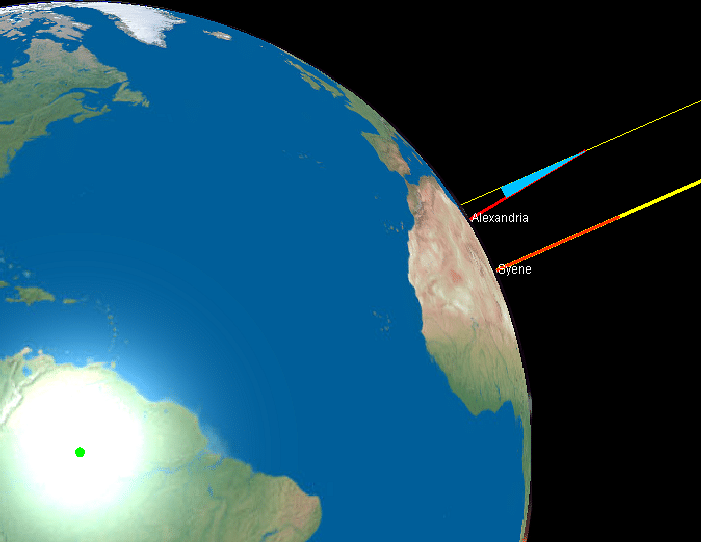
Eratosthenes (276-195 BCE) was an ancient Greek Alexandrian scholar, native of Cyrene, who attained distinction in many fields including philosophy, mathematics, astronomy and history. However, it was in geography where he proved to be more skillful for he was one of the greatest of all ancient geographers. Eratosthenes was also known as Beta : his erudition in many disciplines was remarkable but he often ranked second in all of them. It seems this nickname was chosen by those who disliked him, since Eratosthenes eventually proved that he was one step ahead of his contemporaries in several important areas of learning.
He was friends with Archimedes and the two exchanged ideas, enlarging each others knowledge. In fact, one of the surviving works of Archimedes, The Method, explained to Eratosthenes how mechanical experiments can help the understanding of geometry and this work also helped to encourage experimental methods in Eratosthenes. We can also see here the difference in approach between ancient and modern science. Ancient science used experimentation to help theoretical understanding while modern science uses theory to pursue practical results.
HISTORICAL CONTEXT
Around Eratosthenes' time the Greek cities of Egypt and the East were flourishing both materially and culturally and most of them were at their peak. Greek was firmly established as a common tongue as was cultural unity along most of the Mediterranean, especially in the eastern-Mediterranean. Every educated person was familiar with Greek and it was widely used as the medium in diplomacy, literature and science, therefore, a book written in Greek could not only be understood by native Greek speakers but also by virtually every educated non-Greek in Egypt and even the Near East.
BY THE AGE OF 40, ERATOSTHENES' VARIED KNOWLEDGE WAS SO HIGHLY REGARDED THAT PTOLEMY III OFFERED HIM THE ROLE OF DIRECTOR OF THE ALEXANDRIAN LIBRARY.
As a result of a very large Greek speaking audience, thousands of writers wrote hundreds of thousands of books and their number skyrocketed. Therefore, libraries, having existed in the past in Egypt and Mesopotamia mainly as a luxury, soon became a necessity. Ptolemy I, about 290 BCE, established the Museum and, as part of the Museum, the famous Library of Alexandria which ended up overshadowing the Museum in importance and interest, turning into a major centre of scholarship and research.
Books were considered so important that Ptolemy III ordered that every book brought to Alexandria should be deposited in the Library, the owner of the book should receive a copy of it while the Library kept the original. Government officials inspected every ship that arrived to Alexandria looking for books. He also borrowed from Athens many important manuscripts and gave the Athenians a large security deposit for their return. He finally sent back copies to Athens, the Library retained the originals and he told the Athenians they could keep the money as a fine. This ambition for old books became so intense that the art of dyeing and spoiling new manuscripts to sell them as antiquities to collectors of first editions turned out to be a risky but very profitable activity.
ERATOSTHENES' WORKS
His numerous works included various topics. Chronographia sought to accurately determine the dates of the major events in Mediterranean history. In this work he calculated the date of the siege of Troy at 1184 BCE, on the basis of traditional chronologies by the geographer-historian Hecateus. In Geographica he put together many reports from different travellers and explorers in order to describe the physical features of each region and he also explained them through the action of natural phenomena such as water, fire, earthquakes and volcanic eruptions. This work included the accounts of some the most prominent explorers in ancient Greece, including Pytheas of Massalia, who sailed around Scotland to Norway, and possibly to the Arctic Circle about 320 BCE. But it was his essay named On the Measurement of the Earth which challenged his Betanickname and clearly proved Eratosthenes was number one at combining theory with experimentation in order to produce the most accurate results possible at that time.
MEASURING THE EARTH
By the age of forty, Eratosthenes' varied knowledge was so highly regarded that Ptolemy III offered him the role of director of the Alexandrian Library, one of the most important positions which included the obligation of tutoring the crown prince. It was probably here where he read that in Syene (modern Aswan, Egypt), a city located due south of Alexandria, during the summer solstice (June 21st) something curious took place: the shadows of all objects would grow shorter as noon approached and finally, during noon, temple columns would cast no shadow and the sun would shine directly overhead. Deep wells, which at any other time of the year would remain in shadow, would have the sun shining directly down into them. He noticed that in Alexandria, during that same moment, objects would clearly cast a shadow. This account was surely read by many others, but nobody seemed to think it had any particular importance. Eratosthenes, as impossible as it may sound, saw in this report an opportunity to calculate the circumference of the Earth. It occurred to him he could do so by measuring the length of the shadow of the sun in Alexandria at the time when there was no shadow in Syene. On June 21st at noon, he measured the shadow of an obelisk in Alexandria and by simple geometry he calculated that the sun was 7° 14' from overhead.
It is because the surface of the Earth is curved that at the same time there would be no shadow in Syene and a clear shadow in Alexandria. Moreover, the greater the curvature, the bigger the difference in the length of the shadows. The sun is so far away from us that its rays are parallel when they reach the Earth: objects at different angles to the sun's rays would cast shadows of different lengths. Eratosthenes, based on the observed differences in the shadows' lengths, came to the conclusion that the distance between Alexandria and Syene had to be 7° 14' along the surface of the Earth. In other words, if we imagined one obelisk in Alexandria and another obelisk in Syene extending all the way down to the centre of the Earth, they would there intersect at an angle of 7° 14'. Since a full circle has 360°, 7° 14' is roughly one-fiftieth of the total circumference. Thus, the total circumference of the Earth was fifty times the distance from Alexandria to Syene.
The next step then was to find out the distance between Alexandria and Syene. There are different versions on how Eratosthenes attained this goal. Some say that travellers' reports indicated that camels needed 50 days to cover the trip from Alexandria to Syene and that a camel travelled 100 stadia a day. Others say that Eratosthenes hired a man to go from Alexandria to Syene counting the steps needed to complete the trip. What we know for sure is that he estimated the distance to be 5,000 stadia. We do not know exactly about the conversion of stadia into modern measures, but the general concensus is that 5,000 stadia would be around 800 kilometres. Eratosthenes therefore calculated the total circumference of the Earth to be 40,000 kilometres (250,000 stadia ).
Eratosthenes' calculation is about 15% too high, but the accuracy of his figure for the circumference of the Earth would not be equalled until modern times. His method was valid from a theoretical perspective, his measurements of angles were highly accurate but it was his measurement of distance that lacked precision. If he had had an accurate figure for the distance between Alexandria and Syene, his conclusion would have been almost the same as our modern estimations.
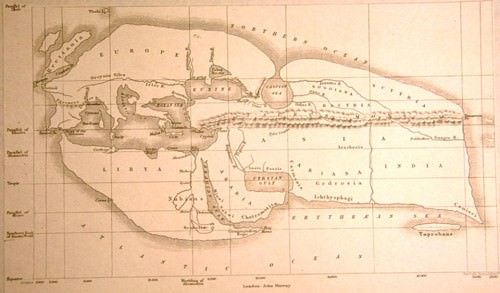
Eratosthenes' Map of the World
MAPPING THE EARTH
Eratosthenes also came up with a technique for charting the Earth's surface. He separated the world known to him into a Northern and Southern division using an east–west line parallel to the equator running through the island of Rhodes and bisecting the Mediterranean. He added a second north–south line at right angles running through Alexandria. Eratosthenes drew additional east–west and north–south lines to his map, but instead of adding these lines in regular intervals, he drew them through famous places: Meroë (the capital of the ancient Ethiopian kings), the Pillars of Hercules, Sicily, the Euphrates River, the mouth of the Indus River and the tip of the Indian peninsula.
The result was an irregular network that served human convenience. For the purpose of giving directions, a regular network would have been more useful, surely Eratosthenes was aware of this. But unfortunately in his day places were located by travellers' reports and oral tradition and this was not good enough to determine sufficient accurate points of reference to draw a regular network. It was Hipparchus of Nicea who later on took the next step and developed a neat regular grid that would provide the means to locate any place by following a simple set of coordinates. Nevertheless, Eratosthenes had certainly proved in his work that theory, observation and experimentation were a powerful and successful combination in the pursuit of knowledge.
Erebuni › Ancient History
Definition and Origins

Erebuni was an Urartian fortress and city, located between the Nor Aresh District and the Vardahsen District on the outskirts of present-day Yerevan, Armenia, and situated on top of Arin Berd hill. In Armenian, the fortress and archaeological site is known as “Arin-Berd” or the “Fortress of Blood,” and the name of this fortress city endures in the word “Yerevan,” which is the capital of Armenia. First constructed during the reign of Arguishti I (r. 786-764 BCE) around the year 782 BCE - some 20 years before the founding of Rome - Erebuni is typically described by historians and archaeologists as one of the mightiest and most impressive Urartian structures in existence.
Erebuni became the primary residence of the Urartian royal family, and thus emerged as a settlement of political and cultural importance in the Near East. Following the collapse of the Urartian states in the early 6th century BCE, Erebuni retained much of its population and importance as the capital of the Persian Satrapy of Armenia under the Achaemenid Empire by the end of the 6th and early 5th centuries BCE. Its strategic location ensured the city's survival as a political and administrative center under independent Armenian kings in antiquity, and the site has been continually inhabited since its founding, expanding further as it developed into the medieval and modern city of Yerevan.
ARGUISHTI I BROUGHT 6,600 CAPTIVES FROM HATTI & SUPANI TO EREBUNI TO HELP POPULATE THE CITY.
HISTORICAL OVERVIEW
Erebuni was the first Urartian fortress constructed north of the Araxes River in the Armenian highlands, and it owes its genesis to the ambitions and martial appetites of Arguishti I who was the sixth king of Urartu. Arguishti I, the archrival and nemesis of Shalmaneser IV of Assyria (r. 783-773 BCE), was responsible for expanding Urartian power and influence into Asia Minor, the Caucasus, and even what is present-day northern Syria. Urartian power reached its zenith during Arguishti's reign, and Erebuni is a testimony in monumental form to his aspiration of projecting Urartian might and power. Needing to secure and delineate political power throughout his domains, Arguishti I ordered the construction of two major fortresses in what is present-day Armenia: Erebuni in 782 BCE and Argishtikhinili in 776 BCE. Rusa II (rc 680-639 BCE) continued this policy by building Teishebaini in the mid-7th century BCE. Unlike neighboring polities in Asia Minor and the Near East, Urartu had localized, political traditions characterized by networks of interlinked and interspersed fortresses rather than massive urban settlements. Uratian kings, like Arguishti I, hoped that compact and strategically positioned fortresses like Erebuni would be able to withhold sieges from large foreign armies and prevent their penetration of the Urartian interior.

Cuneiform Inscription of Arguishti
During the Urartian period, Erebuni emerged as a political and cultural center while Argishtikhinili, located 5 km (3 miles) north of the Araxes River and 15 km (9 miles) from modern day Armavir, Armenia, developed primarily into an economic center.According to cuneiform inscriptions found at Erebuni and in Van, Armenia, Arguishti I brought 6,600 captives from Hatti and Supani to Erebuni to help populate the city. (This is attested by cuneiform inscriptions in Van and also those found by Soviet excavators while Armenia was part of the USSR.) Although the fortress and city remained affluent, Arguishti I's military prowess was never matched by his successors.
PERSIA UNDERTOOK LARGE-SCALE RECONSTRUCTIONS OF THE FORTRESS & EREBUNI BECAME THE CAPITAL OF THE PERSIAN SATRAPY OF ARMENIA.
Faced with Assyrian, Cimmerian, Scythian, and Median enemies, Urartu declined in the 7th and 6th centuries BCE. Despite being raided by Cimmerian forces and the transference of much of its populace and wealth to the Teishebaini fortress, the Erebuni fortress survived and was occupied by the Median Empire around 585 BCE. Due to its prime geographical location, Erebuni became a flourishing political center once again, albeit under the control of the Persian Achaemenid dynasty (550-330 BCE). The Persians undertook large-scale reconstructions of the fortress and Erebuni became the capital of the Persian Satrapy of Armenia. Despite the fact that Persian power collapsed due to the conquests of Alexander the Great (r. 332-323 BCE) in the 4th century BCE, the settlement at Erebuni continued to grow, eventually spreading outwards from the fortress' ancient walls. Artaxata replaced Erebuni as an Armenian capital around c. 188 BCE.
ARCHITECTURE
Situated on the Arin Berd hill and occupying a space of nearly 40 hectares (99 acres), Erebuni offered commanding views of Mount Ararat and access to the fertile Ararat Plain. The citadel of Erebuni occupies nearly 3 hectares (7 acres). Surrounded by defensive walls - in parts up to 15 m (49 ft) in height and 3-4 m (10-13 ft) in width - Erebuni was accessible from an eastern entrance, which offered strategic views of the three-range defensive walls in addition to the Ararat Plain. The main road that led to the citadel rose from the southeastern slope of the hill at a height of 2 m (6.5 ft) and terminated at the fortress' entrance.The entrance walls contained two cuneiform inscriptions:
By the greatness of Gold Chaldis, Argistis, son of Menuas, built this mighty stronghold and proclaimed it Erebuni. The land was desert. For the glory of the country of Biainili and for holding the enemy's countries in awe, by the greatness of God Chaldis, Argistis, son of Menuas, mighty king, king of the country or Biainili, ruler of the town of Tushpah.
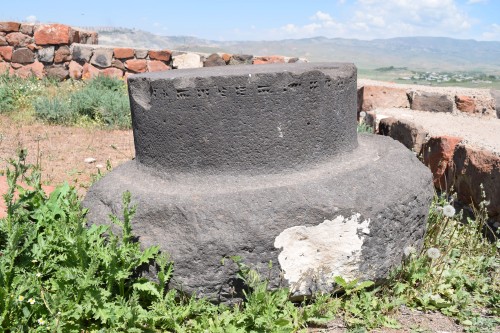
Basalt Pillar with Cuneiform, Armenia
It is likely that the citadel's monumental gate was solid and wooden, and opened to a large central square, which in turn was oriented from the southeast to the northwest. Special sections of the Erebuni fortress served different administrative, residential, and religious purposes: southeast of the main square was the religious section of the fort, including the temple of the Urartian god Khaldi; northwest of the square was occupied by the royal palace, administrative offices, and a temple dedicated to the Urartian god Ivarsa; and to the northeast of the square were residential homes and commercial buildings.Archaeological remains indicate that a ziggurat may have existed on the site too.
The royal palace at Erebuni was especially splendid according to the archaeological remains that have since been uncovered.Archaeologists have determined that the Persians made alterations and reconstructed parts of the administrative complex in the 6th century BCE. Originally, it contained a great hall decorated with frescoes of human figures and natural scenes with wild animals painted in rich hues. After the reign of Sardury II (r. 764-735 BCE), archaeologists suspect that the great hall of the royal palace was turned into a cellar, filled with enormous water and wine jars that could hold up to 40,000 liters (10,567 gallons) worth of liquid. Archaeologists have also uncovered five basalt pillars in the southeastern section of the fortress, which contain inscriptions dating to the reign of Arguishti I. It is believed that a powerful earthquake occurred during the reign of Rusa II, which destroyed parts of the city and palace.
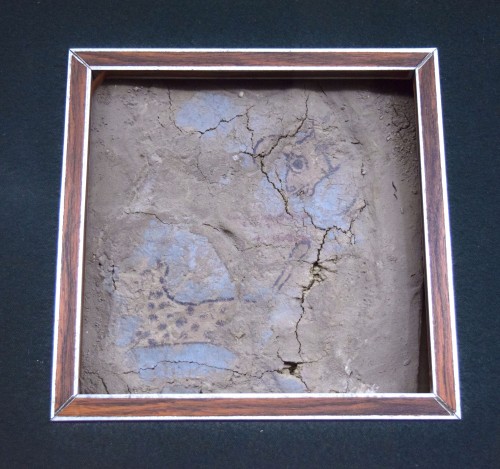
Running Leopard of Erebuni
Khaldi's temple was also decorated with beautiful frescoes, but the Persians later modified the basic temple plan into a rectangular plan during the 6th century BCE. The Persians additionally converted one part of the temple into a pillared hall (apadana). There was a fire temple at Erebuni, and contrary to what would have been considered proper by the Achaemenids, the Armenians sacrificed horses to the sun god, according to the Greek historian Xenophon (c. 430-354 BCE).
EXCAVATIONS & IMPACT ON ARMENIAN CULTURE
The first major excavations at Erebuni began in 1950, under the archaeologist K. Hovhannisyan. A series of Soviet archaeological excavations lead by Konstantin Oganesyan in 1961 and 1969 CE later uncovered most of the artifacts that one sees today in the Erebuni Historical and Cultural Reserve. These excavations revealed a substantial and rich array of cereal and botanical materials preserved after thousands of years. (Archaeologists uncovered grape seeds, sesame oil, lentils, pea, and malted barley for the brewing beer.) Sadly, the massive restoration project of Erebuni fortress in the 1970s CE, which coincided with the 2,750th anniversary of its establishment, did irrevocable harm to the site and its integrity.
Since the collapse of the USSR in 1991 CE and the beginning of hostilities between Armenia and Azerbaijan, there were fewer investigations of the site in the 1990s and early 2000s CE. Recent excavations have focused on Erebuni's later occupations under the Medians, Persians, and Greeks. The imprint of Erebuni on the culture and popular imagination of modern Armenia is undeniable and ubiquitous. The names, symbols, and artifacts associated with Urartian heritage and art have become commonplace as is evidenced by decorative items and company advertising.
[naasr]
MAP
The Temples of Pattadakal › Antique Origins
Ancient Civilizations
The history of Pattadakal goes back to a time when it was called Kisuvolal, a valley of red soil. It even found a mention in Ptolemy's Geography in the 2nd century CE. Presently Pattadakal is located in the district of Bagalkot, state of Karnataka, India. The Chalukyas of Badami (ancient Vatapi) or Early Chalukyas (543-753 CE) built a large complex of temples for royal commemoration and coronation in Pattadakal. This complex is on the left bank of the Malaprabha River which runs further north to meet the river Krishna. It was accorded World Heritage Status by UNESCO in 1987.

Temple Complex in Pattadakal
Pattadakal literally means 'coronation stone' and bears testimony to the later phase of evolution of the distinctive Early Chalukyan architecture. The gestation phase of this development which took place in Aihole, Badami (the ancient capital), Alampur, and Mahakuta finds its culmination here. It is in the last few decades, during the successive reigns of Vijayaditya (696-733 CE), Vikramaditya II (733-746 CE) and Kirtivarman II (746-753 CE), that several temples were gradually constructed in this fertile valley. A Jain shrine was constructed much later, after the collapse of the empire by their successor Rashtrakuta dynasty (6th-10th centuries CE) in the 9th century CE.
TEMPLE ARCHITECTURE
The basic plan of a temple runs thus: the garbha griha (sanctum sanctorum) opens to an antarala (vestibule) and houses the murti (enshrined image) on a pitha (pedestal). An expansive pillared mandapa (hall) adjoins the antarala. A shikhara(superstructure) rises on top of the garbha griha and contains an amalaka (a ribbed stone) with a kalash (pot with mango leaves and a coconut) at its finial. The vimana then comprises both the garbha griha and shikhara.
Temples built here are all dedicated to Shiva and face east. However, depiction of religious motifs through free-standing sculptures and reliefs is not limited to Shaivism but recruits images generously from the Hindu pantheon. Other than the nine Shaiva temples in the compound, there is one Jain temple located almost a kilometre to the west dedicated to the 23rd Tirthankar, Parsvanatha.
VIRUPAKSHA TEMPLE
The epigraphy reveals this to have been built by Queen Loka Mahadevi (originally named as Lokeswara) after the successful military campaigns of King Vikramaditya II against the Pallavas (4th-9th centuries CE). In ground plan it resembles the Kailasnatha temple of Kanchipuram, citadel of the Pallavas, but in stone it is a realisation of the fully mature Early Chalukyan architecture in all its glory.
A square garbha griha, with an ambulatory path surrounding it, is connected to the antarala. Two small shrines are laterally placed to the antarala, one for Ganesha and the other for Mahisasurmardini. Three porches from the east, north and south open up to an expansive mandapa. Further east, a separate Nandi mandapa is placed on a plinth. The whole temple is surrounded by prakara (enclosure) walls that are provided with subsidiary shrines on its inner side. Only a handful of these remain out of the original 32. The magnificently built Dravida shikhara with a well-preserved sukanasa ('nose,' arched projection) on the front is one of the hallmarks of the temple. The superstructure is three-storied and topped by a four-sided amalaka with a kalash at its finial.
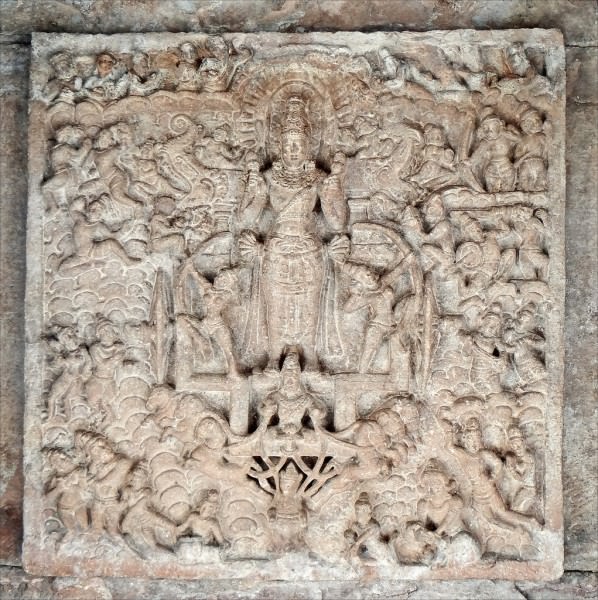
Relief Sculpture of Surya in Virupaksha Temple, Pattadakal
The temple walls are divided into projections and recesses. Sculptures of Harihara, Narasimha, Bhairava, Lakulisha adorn the Devakoshthas (niches) on sanctum walls. Recesses have filigree windows. The temple interior is covered with friezes depicting stories of the abduction of Sita, Bhishma lying on a bed of arrows and Krishna lifting the Govardhan Mountain among other narratives from ancient texts. Many inscriptions have been found engraved in different parts of the temple, some of which also name the architect(s) involved in building the structure.

Hara Gauri in Virupaksha Temple, Pattadakal
MALLIKARJUNA TEMPLE
It was originally called the Trailokeswara temple in honour of the Queen Trailokya Mahadevi. Almost like a twin, the Mallikarjuna temple was built for the same purpose, at the same time as Virupaksha temple which stands beside it. There are only a few noticeable differences between these two, one of them being a hemispherical amalaka as opposed to a four-sided one, and a parapet devoid of certain architectural elements such as kuta (square), sala (oblong) etc. that correspond to the projections and recesses below.
The shrines, lateral to the antarala, are sadly missing the images of their respective deities. Prakara (walls) too are largely destroyed. Tales from the puranas (religious texts) and epics carved inside the temple include sculptures of Mahisasurmardini, samudra manthan, Narasimha fighting Hiranyakashipu, the slaying of Mareecha etc. The niches on temple walls are also gracefully decorated.
SANGAMESWARA TEMPLE
This temple was built in 720 CE by Vijayaditya and originally named as the Vijayeswara temple. The garbha griha typically houses a lingum (phallus symbol) and there are sub-shrines on either side of the antarala. To the east of the mandapa, an image of the bull Nandi ( vahana or 'mount' of Shiva) is supported on a small plinth.
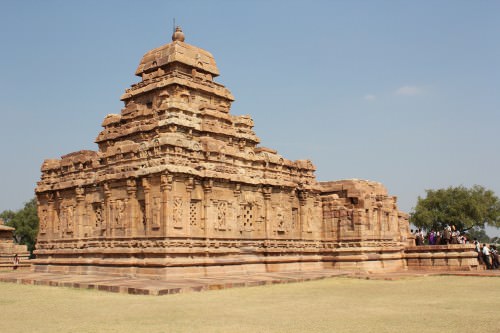
Pattadakal, Sangameswara Temple
The temple itself is built on a high plinth consisting of five mouldings decorated with animal and floral motifs. On the temple walls, niches bearing sculptures of different avatars of Vishnu and Shiva alternate with beautifully designed windows. Below the kapota (eave), a row of wonderfully carved round-bodied figures are placed as if the whole load of the roof above is being held by them. The shikhara is two-tiered and topped by a four-sided amalaka with a kalash.
KADASIDDHESWARA TEMPLE
This modest structure was constructed sometime during the middle to late 7th century CE. It attests to the still evolving Early Chalukyan architecture with its shikhara being developed along the northern style ( rekha nagara ) of curvilinear profile and a simple sukanasa projecting from the superstructure at the front, above the antarala. The sukanasa depicts an image of a dancing Shiva with Parvati as a shallow relief chaitya (prayer hall) arch. The Devakoshthas houses images of Ardhanariswar, Harihara and Shiva on the north, west, and south sides respectively.
The rectangular mandapa might have had a mukha mandapa (porch) at the front as suggested by the plinth, with usual decorative moulds. The figures of Shiva and Parvati grace the lintel of the door to the garbha griha with carvings of Brahmaand Vishnu on either side.
JAMBULINGESWARA TEMPLE
Its ground plan and period of construction are both comparable to the Kadasiddheswara temple mentioned before. The square garbha griha houses a lingum on a pitha and opens to the antarala at front which further expands to a mandapa. A sukanasaprojects from the sikhara (built in northern style in three diminishing stages) at the front. The small Nandi mandapa to the east is in a ruinous state with the crouching image of Nandi all but destroyed. A minutely detailed frieze of swans runs below the cornice of the temple wall all along. The moulded plinth is decorated with figures of Kudu, birds and other ornamental elements.
GALAGANATHA TEMPLE
This temple, one of the last to be built at the site around 750 CE, possesses an exquisitely developed superstructure in the northern style as adopted by Early Chalukyan architects. It has been largely preserved with the amalaka and kalash at the top save for the partially damaged sukanasa at the front.
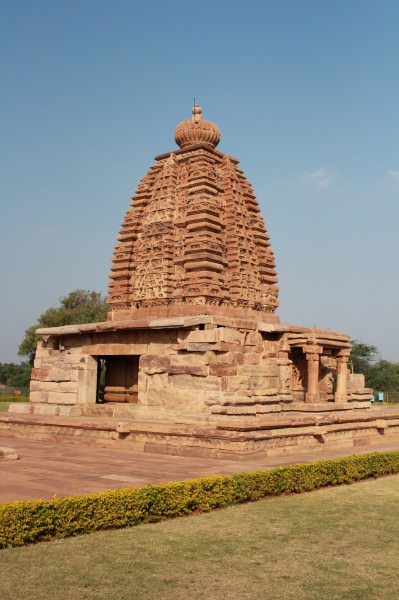
Pattadakal, Galaganatha Temple
The pradakshinapatha (passage for circumambulation) is closed on three sides but the large open space atop the plinth in front of the temple suggests the regrettable loss of the mandapa to the ravages of time. The plinth with three mouldings is luxuriously decorated with playful figures among other common motifs. Stories from Panchatantra and Shiva slaying Andhakasura from the puranas are variously depicted. The entrance to the sanctum is flanked by River Goddesses on both sides with the lintel being carved with a Nataraja.
CHANDRASHEKHARA TEMPLE
This relatively small structure is placed between the Sangameswara and Galganatha temples. There is no superstructure on top of the garbha griha which follows the tradition of enshrining a lingum on a pitha. A Devakoshtha is designed on both the north and south walls of the sanctum. Dwarpalas (door keeper) grace either side of the entrance door to the shrine.
PAPANATHA TEMPLE
Located to the south of Virupaksha temple, it boasts of a vimana of the northern style with an elaborately carved sukanasa at front. Lamentably, both the amalaka and kalash are missing. It is the largest temple in the compound in the rekha nagara(northern) style and seems to have undergone additions and modifications outside those of the original plan. It is possible that the temple, in the beginning, consisted of the typical composition consisting of a sanctum, a rectangular mandapa and a separate Nandi mandapa. Later modification(s) aimed to enlarge the existing mandapa and incorporate an enclosed circumambulatory path around the sanctum. This was extended in such a way that the once separate Nandi mandapa now became a part of it. A finely built Nandi figure now graces the passage at the entrance of the mandapa.
Only one of the dwarpalas now survives at the entrance of the mandapa. Pillars and pilasters inside the hall are resplendently covered with figures in tribhanga mudra (thrice-bent pose), foliage motifs and other elements. Images of Shiva and Parvati, Anantasayana Vishnu surrounded by Dikpalas, Nagaraja, Gajalakshmi are carved on the ceiling while narrative panels depicting episodes from Kirtarjuniya, Ramayana and other ancient texts adorn the walls. The façade of the garbha griha is beautifully decorated with a Garuda on the lintel and decorative pilasters on either side, accompanied by gracefully sculpted figures of Ganga & Jamuna.
KASIVISWESWARA TEMPLE
This is probably the last temple built in this compound, datable to the middle of the 8th century CE. It showcases the wonderfully developed style of rekha nagara shikhara rising in five stages, unfortunately the amalaka and kalash are missing.A well-preserved sukanasa adorns the front of the shikhara with an image of Uma-Maheswara carved within a chaitya arch.The whole shikhara surface is designed in a mesh-like manner.
In plan, the temple follows the general pattern of Early Chalukyan architecture as evidenced in other temples of this location.Sculptures of Ardhanariswara and Kalabhairaba grace the northern side of mandapa wall. The walls are also decorated with paired pilasters supporting the pediments of the elaborately relieved chaitya arches. Stories from Shiva and Bhagavat puranasare also a delight to behold. An exquisitely prepared ceiling panel that lies at the center of the mandapa depicts Shiva, Parvati holding Kartikeya, and Nandi. Beyond the mandapa, further east a small Nandi mandapa, now largely ruined, is placed.
MONOLITHIC STONE PILLAR
A monolithic stone pillar bearing inscription stands in front of the Mallikarjuna temple. The inscription is in Siddhamatrika and Kannada – Tamil characters of 8th century CE. It starts with invocations of Shiva and Hara Gauri and refers to the reigns of Kings Vijayaditya and Vikramaditya II.
JAIN TEMPLE
Locally named the Jain Narayana temple, it was constructed much later during the rule of Rashtrakuta dynasty in 9th century CE. Though built a century after the temple complex and under a different ruler, it follows the basic pattern which was developed during the Early Chalukyan era.
It is a three-storied temple with the two lower stories still functional. The square garbha griha houses an image of Parsvanatha.The adjoining antarala runs into a mandapa and finally a beautifully pillared mukha mandapa graces the visitor. A circumambulatory path, though with collapsed walls, is also present. The superstructure is built in a southern vimana style with a four-sided amalaka at top. The plinth is decorated with triple mouldings.
The projections and recesses of the mandapa walls contain images of Jina in various postures among other figures. The pillars of the porch are partially lathe turned, and the doorway has on either side an elephant with its rider. A large figure of Makara (crocodile) in florid detail marks the entrance to the garbha griha.
The enduring achievement of Early Chalukyan reign in the field of architecture set the stage for future generations to develop their own vocabulary around certain basic attributes. In Pattadakal, for instance, the astonishing evolution that temple architecture underwent is made visible by means of a bewildering variety of structural elements in use only a few metres away from each other. And yet, it represents the culmination of the movement. After well over a millennium, it takes on a new character, that of an intermediate stage that found its continuity and elaboration in later years through the Western Chalukyas (973 CE – 1189 CE) and especially Hoysala Emperors (1026 CE – 1343 CE) who broke new ground in this field.
LICENSE:
Article based on information obtained from these sources:with permission from the Website Ancient History Encyclopedia
Content is available under License Creative Commons: Attribution-NonCommercial-ShareAlike 3.0 Unported. CC-BY-NC-SA License